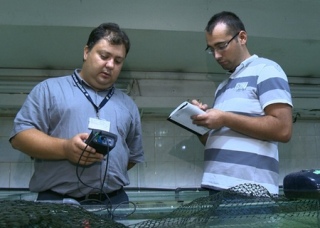Oct 9 2014
A novel autonomous biosensor may help scientists to detect environmental hazards in the sea at an early stage. But applying such approach to the marine environment is a huge challenge.

The marine aquaculture sector has grown continuously over the past years, according to the FAO’s world review of fisheries and aquaculture. But viruses causing fish diseases, chemicals or algal toxins, may adversely affect marine fish and shellfish farms. This often causes considerable economic loss. Scientists within the EU-funded project EnviGuard, running between 2013 and 2018, now develop an autonomous device for the timely detection of environmental hazards. “We want to develop a cheap, rapid and automated system that fish and shellfish farmers can use directly onsite as an early warning system,” says project coordinator Björn Suckow, who is also project manager for water, energy and landscape management at the ttz Bremerhaven, in Germany.
The new device is designed to detect fish viruses, bacteria and toxic microscopic algae. It will also be able to measure toxins released from the algae and chemical contaminants such as polychlorinated biphenyls (PCB). The system will thus also be useful for monitoring the state of the marine environment. “Our aim is to detect substances in seawater that have so far been hard to measure”, Suckow tells CommNet.
To achieve this, the scientists want to integrate three different types of biosensors into one system. The sensors will consist of tiny chips applying different measuring principles. They rely on the use of molecular probes, antibodies or so-called aptameres - small molecules containing nucleic acids (DNA components) - which specifically bind to the various substances to be detected. This triggers an optical signal, subsequently converted into an electronic signal, before being collected in a common interface.
Some challenges remain before this biosensor can be turned into a portable device. For example, the sensors have to be very specific and sensitive. This is “because the concentrations of the different substances are usually quite low,” Suckow says. Also, the scientists need to resolve how to prepare the water samples prior to the actual measurements. Another issue is the modular setup of the device. “The advantage is that the system can be adapted to the customers’ need”, Suckow says. But the sensors need to be compatible and produce a uniform signal, he points out.
One expert welcome this development. “It is a new idea to combine chemical and biological measurements in one device”, says Madeleine Goutx, head of the environmental chemistry research group at the Mediterranean Institute of Oceanography in Marseille, France. “I am fully convinced that this is the way to go forward in marine science. You really need continuous recording of environmental parameters,” she tells CommNet. This is because shifts in the environmental conditions can occur quickly within hours.
However, the scientists need to have a lot of expertise to succeed in developing the device within the project’s lifetime, Goutx points out. But she is convinced that the project will advance the field even if the scientists only manage to develop a prototype. For example, when actually measuring algal toxins, scientists “will learn where these toxins enter the food web and at which concentrations, which is still not well known,” she says.
Another expert is impressed by the project’s scope. “It is an extremely challenging task in terms of autonomous in-situ sensing”, says Dermot Diamond, director of the National Centre for Sensor Research at Dublin City University in Ireland. Because of the harsh environmental conditions in the sea, “the device needs to be incredibly robust,” he says. Diamond also holds that “highly sensitive and selective methods” are necessary for obtaining reliable results. But in his view the project consortium has chosen the appropriate methods to reach this aim. Although it is one of “the most challenging issues of modern science to make the methods work in the incredibly hostile marine environment”, he notes. Diamonds also welcomes the project’s focus on sampling strategies. “This is very important. Even the best sensor is useless if you don’t have proper sampling”, he says.